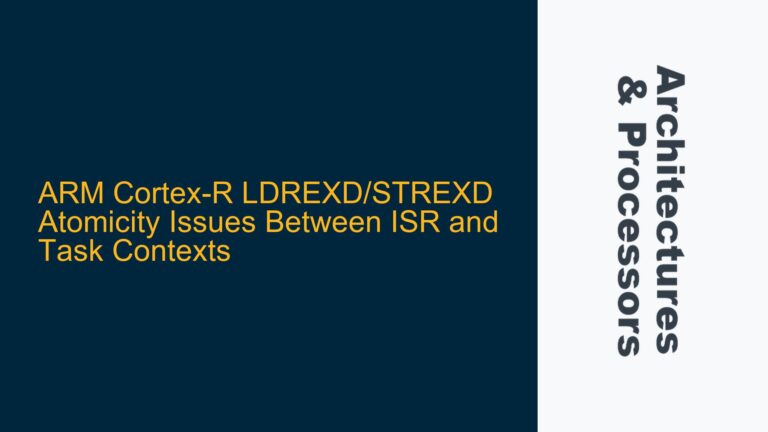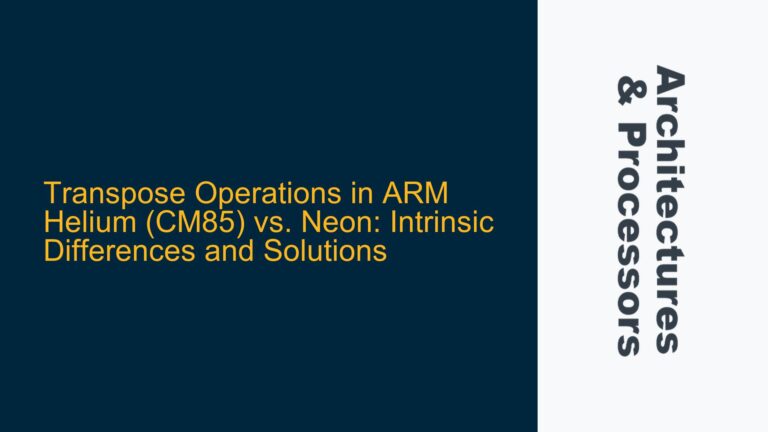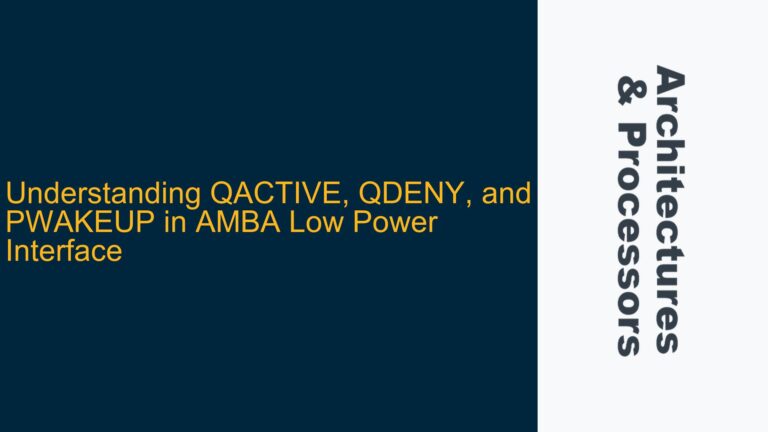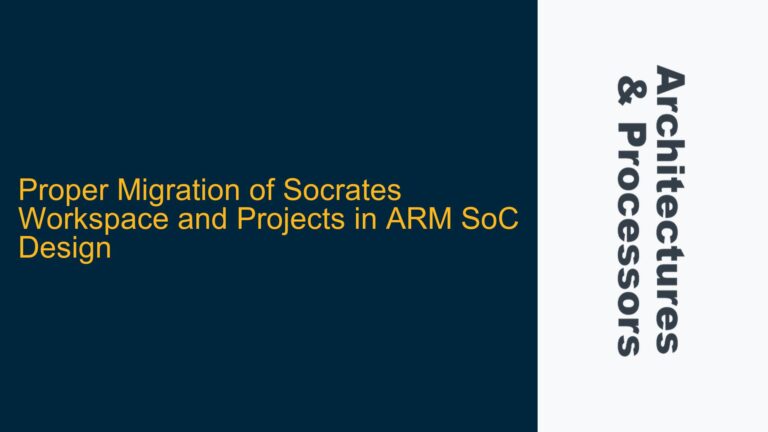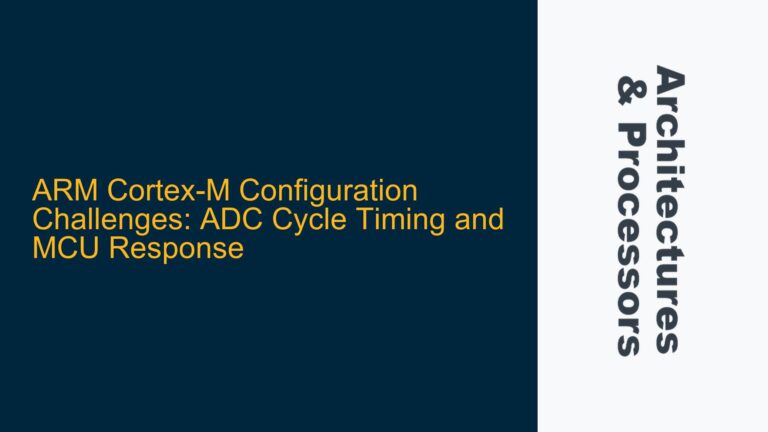ARM Cortex-A35 and Mali-400 Cache Coherency Requirements
In modern SoC designs, integrating multiple processing units such as CPUs and GPUs often introduces challenges related to cache coherency. The ARM Cortex-A35 CPU and Mali-400 GPU are two such units that may operate on shared data, necessitating a clear understanding of their cache behaviors and coherency mechanisms. The Cortex-A35 typically includes L1 and L2 caches, while the Mali-400 GPU also incorporates its own cache structures. When these units access shared memory regions, the lack of hardware-enforced cache coherency can lead to data inconsistency issues. This is particularly critical in scenarios where the Mali-400 processes large datasets that are also accessed by the Cortex-A35 for configuration or further computation.
The primary concern arises from the fact that the Mali-400 GPU does not natively support hardware cache coherency with the Cortex-A35 CPU. This means that if both units cache the same memory region, modifications made by one unit may not be immediately visible to the other, leading to stale data usage and potential system failures. For instance, if the Cortex-A35 configures the Mali-400 by writing to a shared memory region, the Mali-400 might not see the updated configuration if it has previously cached the old data. Similarly, if the Mali-400 writes processed data to a shared memory region, the Cortex-A35 might read outdated data from its cache.
To address these challenges, it is essential to understand the types of data exchanged between the Cortex-A35 and Mali-400. Configuration data, which is typically small and infrequently updated, can often be marked as non-cacheable to avoid coherency issues. However, large datasets used for processing or rendering may benefit from caching to improve performance. In such cases, software-managed cache coherency mechanisms must be implemented to ensure data consistency.
Absence of Hardware Cache Coherency Between Mali-400 and Cortex-A35
The absence of hardware cache coherency between the Mali-400 GPU and Cortex-A35 CPU is a significant architectural consideration in SoC design. Unlike systems that utilize ARM’s CoreLink CCI (Cache Coherent Interconnect), which provides hardware-enforced coherency across multiple agents, the Mali-400 and Cortex-A35 do not inherently support such mechanisms. This lack of coherency can be attributed to several factors, including the Mali-400’s design focus on graphics processing rather than general-purpose computing, and the Cortex-A35’s target applications which may not always require GPU integration.
One of the primary reasons for this design choice is the performance and power trade-offs associated with hardware cache coherency. Implementing hardware coherency across multiple units can introduce additional latency and power consumption, which may not be justified for all use cases. For example, in embedded systems where power efficiency is critical, the overhead of maintaining cache coherency might outweigh the benefits. Additionally, the Mali-400’s cache architecture is optimized for graphics workloads, which often involve large, streaming data accesses that are less sensitive to coherency issues compared to general-purpose computing tasks.
Another factor is the complexity of integrating hardware coherency mechanisms. The Mali-400 and Cortex-A35 may operate at different clock domains or have different memory access patterns, making it challenging to implement a unified coherency protocol. Furthermore, the Mali-400’s cache management is typically handled by its driver software, which may not be designed to interact with the Cortex-A35’s cache coherency protocols.
Given these constraints, it is crucial for SoC designers to carefully consider the data flow between the Mali-400 and Cortex-A35. Configuration data, which is usually small and infrequently updated, can be marked as non-cacheable to avoid coherency issues. However, for large datasets that benefit from caching, software-managed coherency mechanisms must be employed to ensure data consistency.
Implementing Software-Managed Cache Coherency and Memory Attributes
To address the lack of hardware cache coherency between the Mali-400 GPU and Cortex-A35 CPU, software-managed coherency mechanisms must be implemented. These mechanisms involve explicit cache management operations and careful configuration of memory attributes to ensure data consistency.
One approach is to use non-cacheable memory regions for shared data that is infrequently updated, such as configuration data. By marking these regions as non-cacheable, both the Mali-400 and Cortex-A35 will access the data directly from main memory, avoiding any coherency issues. This approach is straightforward and effective for small, infrequently updated data, but may not be suitable for large datasets that benefit from caching.
For large datasets that require caching, software-managed coherency mechanisms must be employed. This typically involves using memory barriers and cache maintenance operations to ensure that data modifications are visible to all units. For example, when the Cortex-A35 updates a shared memory region, it must perform a cache clean operation to ensure that the updated data is written back to main memory. Similarly, the Mali-400 must perform a cache invalidate operation to ensure that it fetches the latest data from main memory.
In addition to cache maintenance operations, memory attributes can be configured to control caching behavior. For example, the Cortex-A35’s MMU (Memory Management Unit) can be configured to mark shared memory regions as write-through or write-back, depending on the specific requirements of the application. Write-through caching ensures that data is immediately written to main memory, reducing the risk of coherency issues but potentially impacting performance. Write-back caching, on the other hand, allows data to be written to the cache first, improving performance but requiring explicit cache maintenance operations to ensure coherency.
Another consideration is the use of shared memory regions with specific attributes to control caching behavior. For example, the Cortex-A35’s MMU can be configured to mark shared memory regions as non-cacheable, write-through, or write-back, depending on the specific requirements of the application. This allows for fine-grained control over caching behavior and can help mitigate coherency issues.
In summary, the lack of hardware cache coherency between the Mali-400 GPU and Cortex-A35 CPU requires careful consideration of data flow and the implementation of software-managed coherency mechanisms. By using non-cacheable memory regions for infrequently updated data and employing cache maintenance operations for large datasets, SoC designers can ensure data consistency and avoid coherency issues. Additionally, configuring memory attributes to control caching behavior can provide further flexibility and optimization opportunities.
Detailed Cache Management Strategies for Mali-400 and Cortex-A35 Integration
Effective cache management is critical when integrating the Mali-400 GPU and Cortex-A35 CPU in an SoC design, especially given the absence of hardware cache coherency. The following strategies provide a comprehensive approach to managing cache coherency and ensuring data consistency between these two units.
Cache Maintenance Operations
Cache maintenance operations are essential for ensuring data consistency between the Mali-400 and Cortex-A35. These operations include cache clean, invalidate, and clean-and-invalidate operations, which must be performed at appropriate points in the data flow to ensure that modifications made by one unit are visible to the other.
-
Cache Clean: This operation ensures that any modified data in the cache is written back to main memory. For example, when the Cortex-A35 updates a shared memory region, it must perform a cache clean operation to ensure that the updated data is written to main memory. This ensures that the Mali-400 will see the updated data when it accesses the same memory region.
-
Cache Invalidate: This operation ensures that any stale data in the cache is discarded and the latest data is fetched from main memory. For example, when the Mali-400 is about to access a shared memory region that may have been modified by the Cortex-A35, it must perform a cache invalidate operation to ensure that it fetches the latest data from main memory.
-
Cache Clean-and-Invalidate: This operation combines the effects of a cache clean and invalidate operation. It ensures that any modified data in the cache is written back to main memory and that any stale data is discarded. This operation is useful when both units may have modified the same memory region and the latest data must be fetched from main memory.
Memory Barrier Instructions
Memory barrier instructions are used to enforce the order of memory operations and ensure that cache maintenance operations are performed in the correct sequence. For example, when the Cortex-A35 updates a shared memory region and performs a cache clean operation, it must also issue a memory barrier instruction to ensure that the cache clean operation is completed before the Mali-400 accesses the memory region.
Memory Attribute Configuration
Configuring memory attributes is another important aspect of cache management. The Cortex-A35’s MMU can be configured to mark shared memory regions as non-cacheable, write-through, or write-back, depending on the specific requirements of the application.
-
Non-Cacheable: Marking a memory region as non-cacheable ensures that both the Mali-400 and Cortex-A35 access the data directly from main memory, avoiding any coherency issues. This is suitable for small, infrequently updated data such as configuration data.
-
Write-Through: Marking a memory region as write-through ensures that any write operations are immediately written to main memory, reducing the risk of coherency issues but potentially impacting performance.
-
Write-Back: Marking a memory region as write-back allows data to be written to the cache first, improving performance but requiring explicit cache maintenance operations to ensure coherency.
Software-Managed Coherency Protocols
In addition to cache maintenance operations and memory attribute configuration, software-managed coherency protocols can be implemented to ensure data consistency. These protocols involve explicit synchronization points in the software where cache maintenance operations are performed to ensure that data modifications are visible to all units.
For example, when the Cortex-A35 updates a shared memory region, it can signal the Mali-400 to perform a cache invalidate operation before accessing the memory region. Similarly, when the Mali-400 updates a shared memory region, it can signal the Cortex-A35 to perform a cache invalidate operation before accessing the memory region.
Performance Considerations
While software-managed coherency mechanisms can ensure data consistency, they may introduce additional latency and overhead. It is important to carefully consider the performance impact of these mechanisms and optimize them for the specific requirements of the application.
For example, cache maintenance operations can be batched to reduce the number of operations performed. Additionally, memory barriers can be used to minimize the impact of cache maintenance operations on performance.
Debugging and Verification
Debugging and verifying cache coherency issues can be challenging, especially in complex SoC designs. It is important to use simulation and emulation tools to verify the correctness of cache management strategies and identify potential issues early in the design process.
For example, simulation tools can be used to model the behavior of the Mali-400 and Cortex-A35 and verify that cache maintenance operations are performed correctly. Emulation tools can be used to test the design in a real-world environment and identify any performance bottlenecks or coherency issues.
In conclusion, effective cache management is critical when integrating the Mali-400 GPU and Cortex-A35 CPU in an SoC design. By using cache maintenance operations, memory barrier instructions, and memory attribute configuration, SoC designers can ensure data consistency and avoid coherency issues. Additionally, software-managed coherency protocols and performance optimization techniques can help mitigate the impact of these mechanisms on performance. Finally, debugging and verification tools should be used to ensure the correctness of cache management strategies and identify potential issues early in the design process.

